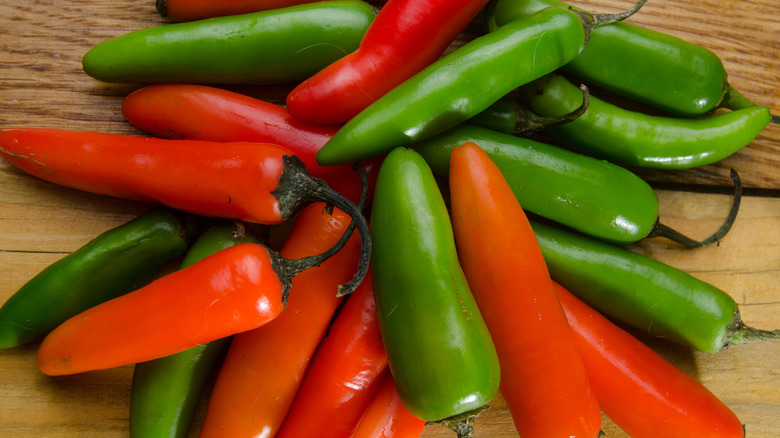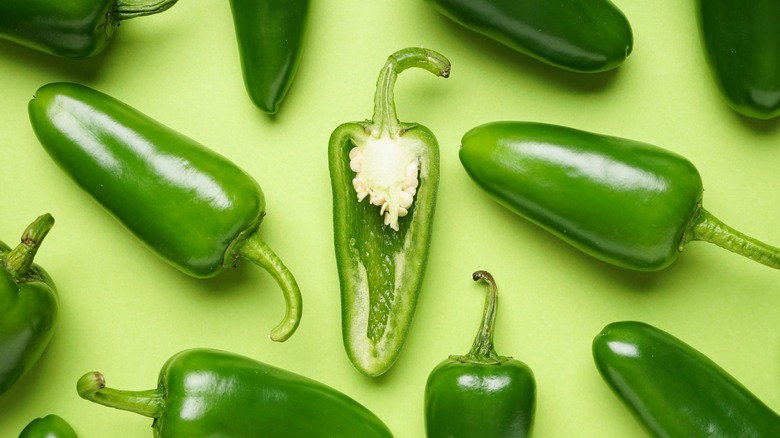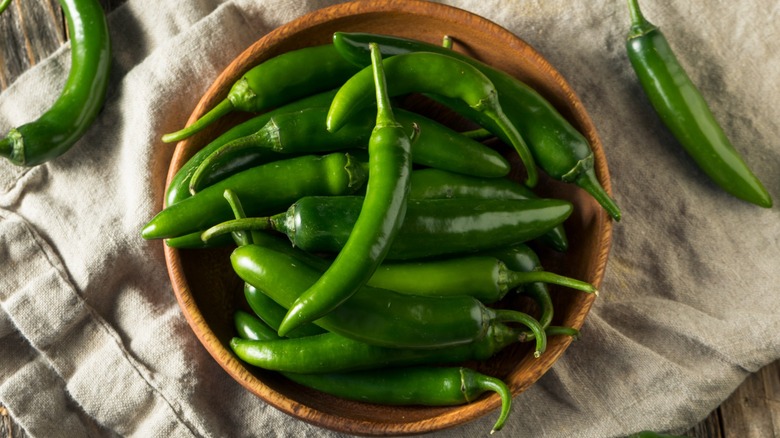Here Are The Main Differences Between Jalapeño And Serrano Peppers
There are numerous different kinds of peppers, all with different primary uses. From sweet red peppers to habaneros, all peppers feature different characteristics, but they can sometimes be difficult to see. Such is the case with jalapeño peppers and the somewhat similar-looking serranos. While they may have some commonalities in color, texture, and even flavor, jalapeño and serrano peppers actually do vary in appearance, and widely differ in level of spiciness.
Both of these sweet and grassy peppers are fairly easy to come by in the grocery store or supermarket, and both add a flavorful and fiery bite to your favorite dishes. But when you're ready to whip up a batch of cast iron jalapeño cornbread or embrace a bowl of spicy serrano pico de gallo, it's important to understand the differences between these two related peppers in order to achieve the best results. This will allow you to easily identify them in the store and to know what to expect in terms of heat once you get them home.
Jalapeños and serranos look slightly different
When selecting peppers from a lineup at the market, you'll see distinct differences in the appearance of jalapeño and serrano peppers. Both peppers have a fairly smooth, firm skin, in contrast to the bumpy texture of peppers like shishitos. However, sometimes jalapeños may have white streaks on the skins, while serranos remain unblemished by lines. Serranos are typically longer and thinner, though both peppers can range in length from one to four inches or more.
A big difference is that jalapeños are noticeably plumper than serranos. They also differ slightly in shape. Both are fairly straight, with minimal curvation, but the jalapeño has a rounded end while the serrano features a pointed tip. When it comes to color, both types of peppers are commonly sold green. This is actually the immature form of the fruit (yes, peppers are a fruit — and also a vegetable). At maturity, serrano peppers can be red, brownish-orange, or yellow, while jalapeño peppers are often red or brown when fully ripened.
Serranos are much hotter
While the differences in appearance are visible, the inside of these peppers holds a spicy secret: Serrano peppers are up to four times hotter than jalapeños. That's a lot of punch in a little package. The spiciness of peppers is measured by the amount of a compound called capsaicin that they contain. This is the component that registers as spicy on the tongue and it's recorded on the Scoville Scale in Scoville Heat Units (SHU).
Depending on many factors, such as the weather during a particular growing season and the level of maturity, the SHU between one pepper and another can vary widely, even within the same species. The range for serrano peppers is 10,000 to 25,000 SHU, while jalapeños range between 2,500 and 8,000 SHU. With these similarities and differences established, many people wonder if it's okay to swap one pepper for another.
In most cases, the answer is yes. However, because serranos are typically much hotter, you'll want to dial back on the quantity until you establish the right amount to achieve your desired results. Also, serranos aren't the best choice for jalapeño poppers, simply because of their shape and size. Otherwise, feel free to replace jalapeños with serranos in chili, or vice versa in dips and hot sauces.


